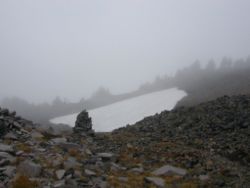Jefferson Park Ridge Hike
From Oregon Hikers Field Guide
- Start point: Breitenbush Trailhead
- Ending Point: Park Ridge
- Trail Log: Trail Log
- Distance: 7.4 miles round trip
- Elevation gain: 1500 feet
- Difficulty: Moderate
- Seasons: July - September
- Family Friendly: No
- Backpackable: Yes
- Crowded: Somewhat
Contents |
Hike Description
After having driven here on one of the worst access roads in this part of Oregon, you'll no doubt be wondering if this hike is worth the trouble it took getting there. It most definitely is. If you are only going to Park Ridge, you'll be treated at the top with an impossibly great view of Mount Jefferson, and should you choose to continue on down to Jefferson Park, you'll discover an alpine wonderland of gorgeous lakes and meadows filled with wildflowers, with Mt. Jefferson filling the sky above you. Once you've been to Jefferson Park, you'll want to keep going back-it's that fantastic.
The trail (the Pacific Crest Trail, actually) begins at the Breitenbush Trailhead, at an elevation of 5,500 feet. Not surprisingly, snow lingers here well into July. You'll start through small meadows and forests of small trees. At about mile 0.6, you'll notice a small reroute including a new bridge over a rocky channel that's usually dry most of the hiking season. An informal trail leads westward from the older route to Pyramid Butte.
The Crest Trail climbs through a large talus area with views of Pyramid Butte, bright red Ruddy Hill and Olallie Butte, then resumes climbing through huckleberry meadows. The trail crosses a saddle at mile 1.5 and you'll get your first views of Mt Jefferson, even though it's just the highest peak. The trail flattens for a bit, then resumes a well-graded climb into subalpine terrain. The views expand to the west as the trail climbs. There are a couple of small ponds near mile 3, near the edge of timberline.
The land takes on a foreboding look above timberline. There's very little soil here and as a consequence very little plant life. The rocks form large hills resembling castles or monuments. Square, broken pieces of rock form aprons around the bases of the hills. Small seasonal streams drain lingering snowfields deep into September. As you approach the ascent of the ridge, pay close attention to the trail and to the cairns that mark the way. There are a few sections in which it is very easy to lose the trail. As you near the crest of Park Ridge, cross one or multiple (depending on the time of year) snowfields and reclaim the trail, which at this point is very dusty and only occasionally well-defined. Finally, crest Park Ridge and look at the incredible sight in front of you: Mt. Jefferson dominating the view, just 4 or so miles to the south of you. On a nice day (and you really shouldn't do this hike on a rainy day, unless your sole interest is solitude), the top of Park Ridge is a fantastic spot to stop for lunch, and to sit and soak in the impossibly great view of Mt. Jefferson.
Maps
Fees, Regulations, etc.
- Northwest Forest Pass required at the trailhead.
Trip Reports
- Search Trip Reports for Jefferson Park
Related Discussions / Q&A
- Search Trail Q&A for Jefferson Park
Guidebooks that cover this hike
- 100 Hikes in Northwest Oregon by William Sullivan
- 100 Classic Hikes in Oregon by Douglas Lorain
More Links
- Jefferson Park Ridge - site created by Portland Hiker Splintercat
Contributors
- mattisnotfrench (creator)





